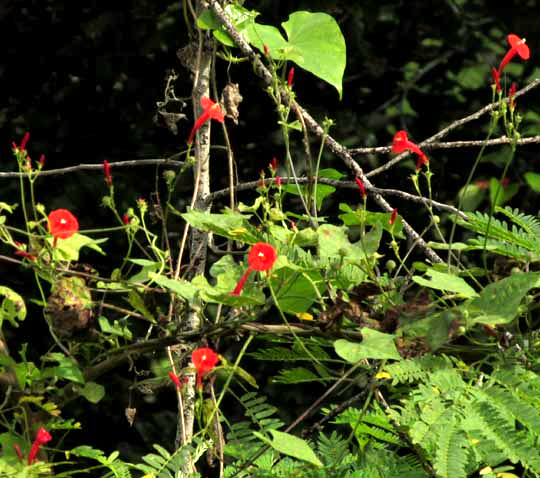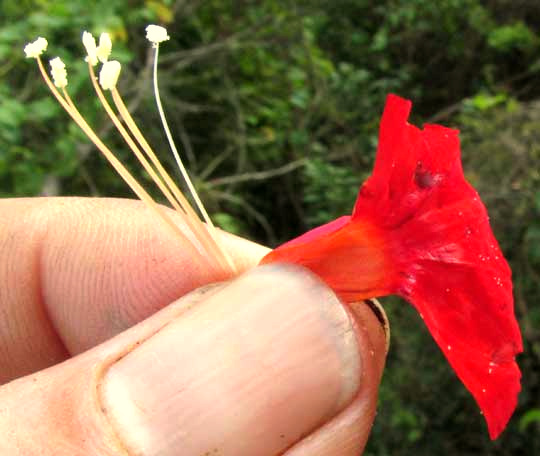Excerpts from Jim Conrad's
Naturalist Newsletter
from the December 13, 2015 Newsletter issued from Hacienda Chichen Resort beside Chichén Itzá Ruins, central Yucatán, MÉXICO
RED MORNING GLORY
Among the colorful riot of morning glory vines gracing our landscape these days there's a species that, though its flowers are smaller than those of most morning glories -- only about an inch long (2.5cm) -- are brilliantly red, and very eye-catching. This sometimes weedy, fairly common roadside vine climbs to the top of shrubbery and sets its crimson blossoms even higher atop long peduncles that overtop the herbage, as seen below:
 .
.
A close-up showing the flowers' white anthers extending well beyond the corolla tube -- different from most morning glory species -- and how the corollas' narrow tubes abruptly expand at their mouths is shown below:

There we also see the vine's heart-shaped leaves, whose smooth margins sometimes develop low, pointy lobes, so that they almost look like ivy leaves.
The flowers are so unlike most morning glory blossoms that it's a good idea, just to firm up the identity, to take a closer look at the flower structure, which is done below:

In that picture, in the cluster of slender items at the left, the right-most item in the cluster is whiter and slenderer than the five other things, and the roundish thing atop it is more spherical. That's because the five items at the left are stamens topped with pollen-producing anthers, while on the right we have the flower's style, with the spherical structure being its stigma. The stigma's spherical, or "globose," shape is important to notice because in the Morning Glory Family, the Convolvulaceae, certain genera closely related to "real morning glories," but which themselves are not members of the morning glory genus Ipomoea, possess oblong or otherwise slender stigmas -- notably the bindweeds. But our vine's globose stigma puts it in good standing among "real morning glories," genus Ipomoea.
Our red-flowered morning glory is IPOMOEA HEDERIFOLIA, not to be confused with the abundant and weedy Ipomoea hederacea, the Ivy-leaved Morning Glory, with similar, ivy-like leaves but very different flowers. Our red-flowered vine is native to tropical and subtropical North, Central and South America, and is even found in the US Southeast and farther north along the coast. Since it occurs in the US and draws such attention to itself, it's graced with many English names, including Red Morning Glory, Cardinal Vine, Scarlet Morning Glory, Starglory, Redstar, Mexican Morning Glory, Scarlet Creeper, Trompillo, and many others.
In Mississippi we had a commonly occurring and often-planted morning glory with very similar blossoms, the Cypress Vine. However, Cypress Vine's leaves were finely dissected, reminiscent of green fish skeletons, or combs with teeth on both sides. That was Ipomoea quamoclit. Sometimes the two species hybridize, suggesting that they share a recent ancestor. It's striking that two species with such similar flowers can produce such drastically different leaves.
Interestingly, though Red Morning Glory's flowers are clearly adapted for pollinators such as long-beaked hummingbirds and hawk-moths with long proboscises, they're capable of self-pollination.